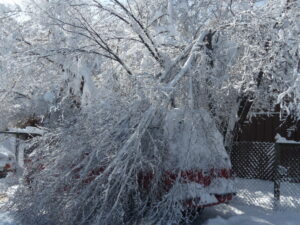
FORT COLLINS, Colo. – Coloradans who are dealing with broken tree limbs after this past weekend’s snowstorm may be considering actions to protect and repair them.
Dana Coelho, Urban and Community Forestry Program Manager for the Colorado State Forest Service, said that although the first impulse may be to start cutting when a tree is damaged, homeowners should first assess the situation to avoid hurting themselves or further damaging the tree.
The CSFS offers the following tips for dealing with snow-damaged trees; these tips were adapted from International Society of Arboriculture (ISA) recommendations:
- Check for hazards. Before approaching a tree, examine your surroundings to avoid making contact with downed utility lines or standing under broken, hanging branches. Contact your utility company if a tree is affecting power or other utility lines.
- Contact city officials if necessary. Trees between the street and a city sidewalk may be the responsibility of city crews.
- Assess the damage. If a tree is healthy overall and still possesses its leader (the main upward branch), most of its major limbs and 50 percent or more of its crown, the chance is good for a complete recovery.
- Be careful knocking snow off branches. This may cause the branches to break. If you must remove snow, gently push up on branches from below to prevent adding additional stress.
- Remove broken branches. This minimizes the risk of decay and insects or diseases entering the wound. Prune at the branch collar (the point where a branch joins a larger one) and be mindful of potential pent-up energy if the branch is twisted or bent.
- Don’t over-prune. With the loss of some branches, a tree may look unbalanced, but most trees quickly grow new foliage that hides bare areas. Wait to prune further. Once a tree leafs out for the year and starts growing, you will find most trees fared better than they initially appear.
- Don’t try to do it all yourself. If the job requires running a chainsaw overhead, sawing from a ladder or removing large branches or entire trees, contact an insured, certified arborist.
For more information about tree care and protection, visit the Colorado State Forest Service website at csfs.colostate.edu, or refer to the Caring for Storm-Damaged Trees quick guide. To find an ISA-certified arborist, visit www.isa-arbor.com.

